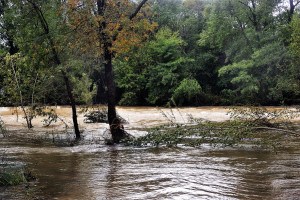

 The federal government’s National Flood Insurance Program has secured more than $1 billion in reinsurance from 25 global reinsurers to help it weather major storms.
The federal government’s National Flood Insurance Program has secured more than $1 billion in reinsurance from 25 global reinsurers to help it weather major storms.
Participating reinsurers include Swiss Re America, Munich Re America, Everest Re, Liberty Mutual, TransRe and various Lloyd’s syndicates.
This is only the second time in its history that the NFIP has turned to reinsurance. The Federal Emergency Management Agency (FEMA), which manages the NFIP, announced that 25 reinsurers would handle the coverage, which is effective Jan. 1, 2017 through Jan. 1, 2018.
Under the agreement, the reinsurers agreed to indemnify FEMA for flood claims on an occurrence basis. The layer is structured to cover 26 percent of losses between $4 billion and $8 billion. A combined total of $1.042 billion of the NFIP’s flood risk was transferred to the private reinsurance market through this agreement.
FEMA contracted with reinsurance broker Guy Carpenter to assist in securing the reinsurance placements.
Historically, the flood program had been limited to using flood insurance premiums, available surplus, borrowing capacity from the U.S. Treasury and direct appropriations from Congress to pay claims.
But Congress recently provided FEMA the authority to secure reinsurance from the private reinsurance and capital markets. The Biggert-Waters Flood Insurance Reform Act of 2012 and the Homeowner Flood Insurance Affordability Act of 2014 authorized FEMA to secure reinsurance from the private reinsurance and capital markets.
Several times over the past decade, flood insurance claims have exceeded the amount of funds available to pay for the insured losses, leaving the NFIP $23 billion in debt to the U.S. Treasury. Claims of $16.3 billion from Hurricane Katrina and $8.3 billion from Hurricane Sandy have contributed to this debt.
“Securing reinsurance through the NFIP Reinsurance Program is a key step toward achieving the NFIP’s long-term vision of building a stronger financial framework,” said Deputy Associate Administrator Roy Wright. “This reinsurance agreement places the NFIP in a better position to manage losses incurred from major events like Hurricane Sandy.”
Wright noted that while reinsurance helps pay claims from major events, it does not reduce the size of NFIP’s current Treasury debt; rather it is intended to reduce the accumulation of future debt.
Guy Carpenter also brokered FEMA’s first reinsurance purchase last September when FEMA reinsured a small amount—$1 million—as an initial step to building a bigger reinsurance program. That placement was with Transatlantic Reinsurance Co., Swiss Re America Corp. and Munich Reinsurance America Inc. FEMA said at the time it was planning on a larger reinsurance deal in 2017.
While the new program should reduce NFIP’s overall risk, the NFIP will continue to bear the majority of its risk. FEMA has said it will take many years to build up a reinsurance program in which the reinsurance markets bear a significant portion of the NFIP risk.
The NFIP is not the only government insurance program employing private reinsurance. A number of states have reinsurance programs including Florida (Citizens Property Insurance), California (California Earthquake Authority) and Texas (Texas Windstorm Insurance Association).
Here’s a full list of the 25 reinsurers secured by NFIP:
Source: FEMA/NFIP